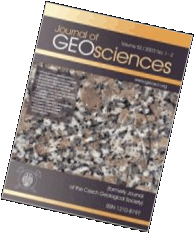 Export to Mendeley
Export to MendeleyMore articles on Crystal chemistry of rock-forming and accessory minerals: Implications for petrogenesis
More articles on Evolved felsic igneous systems and granitic pegmatites
Original Paper
Beryl composition and evolution trends: an example from granitic pegmatites of the beryl-columbite subtype, Western Carpathians, Slovakia
Journal of Geosciences, volume 55 (2010), issue 1, 69 - 80
DOI: http://doi.org/10.3190/jgeosci.060
Beryl is an uncommon but characteristic mineral of Hercynian granitic pegmatites associated with S-type granites-granodiorites of the Bratislava and Bojná massifs, Tatric Unit, Central Western Carpathians (SW Slovakia). Beryl represents the only essential rare-element phase in majority of the pegmatites, whereas accessory Nb-Ta-(Sn) oxide minerals occur in the most evolved ones (Moravany nad Váhom, Jezuitské Lesy). Beryl forms columnar pale green crystals on the boundary between blocky K-feldspar zone and muscovite plus quartz core (beryl I) or locally in saccharoidal and cleavelandite albite unit (beryl II). The EMPA, LA-ICP-MS and XRD data show mostly the presence of common Li, Cs-poor beryl with variable amounts of Na and occasionally small Fe, Mg-enriched domains (up to 3.5 wt. % FeO and 1.8 wt. % MgO), with dominant channel-octahedral substitution represented by the Na(Fe2+,Mg) -1Al-1 exchange. Beryl of the most evolved pegmatites contains moderately elevated Li (up to 5600 ppm; Moravany nad Váhom) or Cs contents (up to 9800 ppm, 1 to 2 wt. % Cs2O in some zones; Jezuitské Lesy), which indicates also a possibility of channel-tetrahedral substitutions. A common patchy internal zoning of primary magmatic beryl I crystals indicates a late-magmatic to subsolidus, partial dissolution-reprecipitation phenomenon. On the contrary, crystals of beryl II show relatively homogeneous internal texture and lower content of Cs than associated beryl I. Consequently, compositional variations and internal texture of the beryl show magmatic to subsolidus evolution of less fractionated, beryl-columbite subtype populations of the granitic pegmatites. The primary evolution trend of beryl shows increasing Cs and Cs/Na with decreasing Mg and Mg/Fe from less evolved to more fractionated pegmatites. However, a secondary evolution trend, probably connected with post-magmatic partial dissolution-reprecipitation, shows decreasing Cs and increasing Mg/Fe in the beryl.
Webdesign inspired by aTeo. Hosted at the server of the Institute of Petrology and Structural Geology, Charles University, Prague.
ISSN: 1803-1943 (online), 1802-6222 (print)
email: jgeosci(at)jgeosci.org


IF (WoS, 2024): 1.3
5 YEAR IF (WoS, 2024): 1.4
Policy: Open Access
ISSN: 1802-6222
E-ISSN: 1803-1943